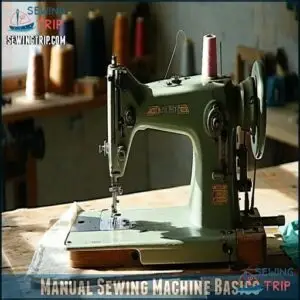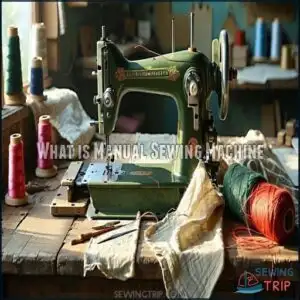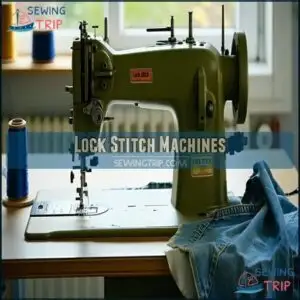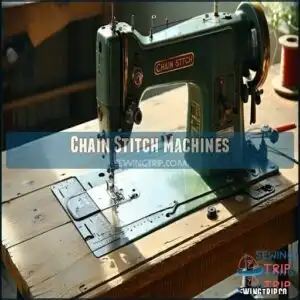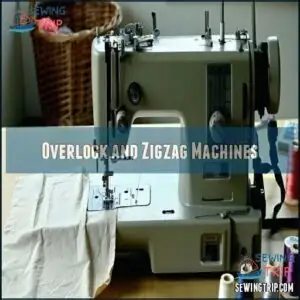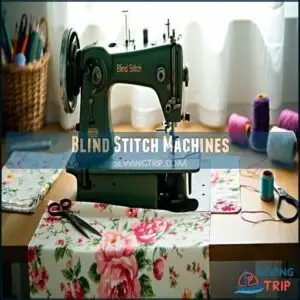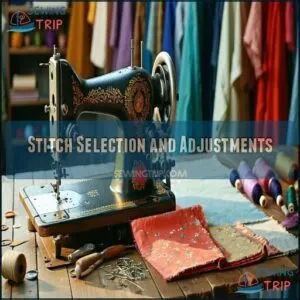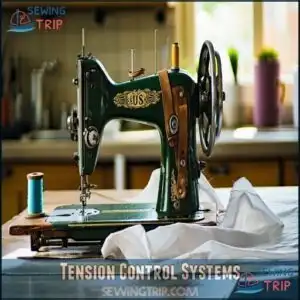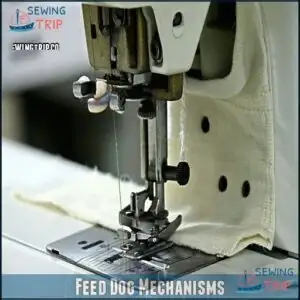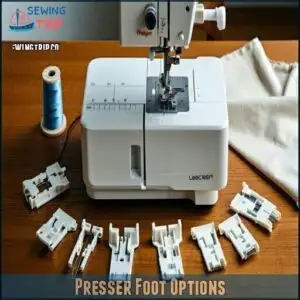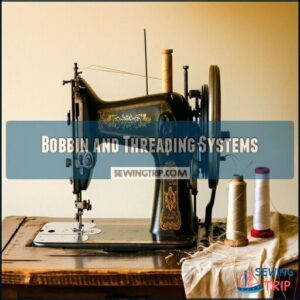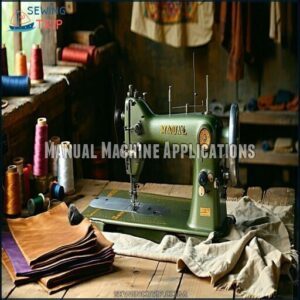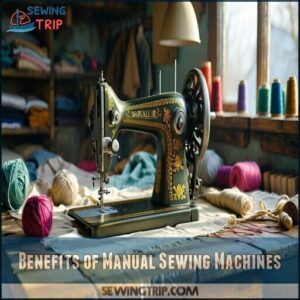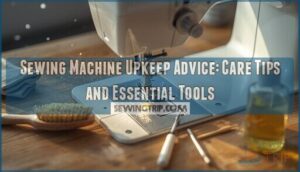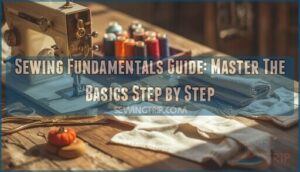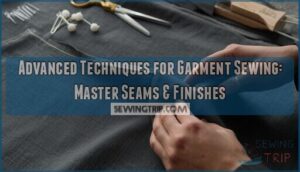This site is supported by our readers. We may earn a commission, at no cost to you, if you purchase through links.
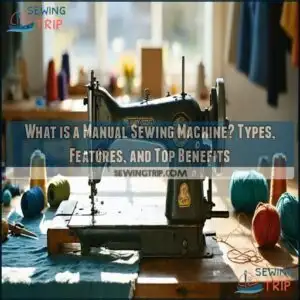
Instead, you power it with a hand-crank or foot-pedal, which might remind you of your grandma’s timeless sewing setup.
It’s all about precision and control—you dictate the speed and rhythm.
These machines are simple, sturdy, and built to last, making them ideal for various projects from mending clothes to crafting decor.
Plus, they’re great for learning stitching basics without getting overwhelmed by gadgets.
Think of it as the bicycle of sewing—classic, reliable, and always there when you need it.
Ready to explore the many advantages?
Table Of Contents
Key Takeaways
- You don’t need electricity to use a manual sewing machine since it’s powered by a hand-crank or foot pedal, giving you full control over speed and rhythm.
- They’re durable, budget-friendly, and great for beginners to learn the basics with hands-on precision.
- Manual machines are portable and versatile, handling tasks like repairs, quilting, and sewing heavy fabrics.
- While slower than electric models, they let you focus on stitch quality, fabric handling, and skill development.
Manual Sewing Machine Basics
A manual sewing machine is a straightforward, hand-operated tool that’s been a trusty companion in homes for generations.
It works without electricity, relying on simple mechanisms like a hand crank or foot pedal to stitch fabrics together, which makes it a reliable option for sewing needs.
History of Manual Sewing Machines
The evolution of the manual sewing machine began in the 18th century with hand-operated sewing machines like antique hand-crank models.
These vintage sewing machines revolutionized garment-making through mechanical innovations. Early sewing innovations included treadles powering machine development, enabling precise stitching.
Their historical significance lies in transforming fabric work, as these mechanical sewing machines laid the foundation for modern design while preserving craftsmanship.
Mechanical Operation and Components
A manual sewing machine, often called a non-electric sewing machine, operates through precise mechanical parts like gear systems and needle control mechanisms.
Sewing motors aren’t involved; instead, the hand-operated sewing machine relies on your physical effort. Thread tension is adjusted manually, ensuring control.
Mechanical sewing machines are dependable for tasks requiring simple, consistent stitching without electricity, like a hand crank sewing machine.
Understanding the role of thread management systems is vital for superior performance in manual sewing machines, which involves manual effort.
Hand-Crank Vs. Foot-Pedal Mechanisms
Hand-crank sewing machines offer a nostalgic, hands-on feel, perfect for precise stitches and portability.
Foot-pedal mechanisms, on the other hand, let you focus on guiding fabric, freeing both hands.
Crank systems suit non-electric sewing machines for flexibility, while foot controls feel natural for longer projects.
Both manual sewing machine options bring charm to mechanical sewing machines with skillful, hand-operated simplicity.
Stitch Formation Process
Stitches come together through a harmony of needle movement, thread tension, and fabric stretch.
A manual sewing machine works by guiding the needle to interlock threads as you control sewing speed manually.
This hand-operated sewing machine teaches you sewing machine basics, from stitch types to precise tension adjustments.
It’s a mechanical dance, creating strong, customizable seams through deliberate, user-driven sewing machine operation.
What is Manual Sewing Machine
A manual sewing machine, often called a hand-operated or non-electric sewing machine, is a reliable tool for stitching enthusiasts.
Unlike its computerized cousins, it’s all about manual controls, making it perfect for those who love a hands-on approach. These mechanical sewing machines operate through either a hand-crank or a foot-pedal mechanism, offering control over sewing speed and precision.
They shine at handling various fabrics without relying on electricity, making them eco-friendly and portable. Manual sewing machines also utilize a basic stitching mechanism similar to a portable sewing device, which is ideal for quick repairs.
Some key reasons to choose a manual sewing machine:
- Fabric Handling: Perfect for delicate adjustments and tricky fabrics.
- User Safety: Slower sewing speed reduces accidents, great for beginners.
- Machine Maintenance: Durable, simple designs mean fewer breakdowns.
A manual sewing machine may lack frills, but it’s a timeless companion for any sewing project.
Manual Machine Types
You’ll find manual sewing machines come in a variety of types, each designed to handle specific stitching tasks.
From lock stitch to blind stitch machines, these options combine simplicity with functionality to tackle your sewing needs, including the use of a blind stitch machine.
Lock Stitch Machines
Lock stitch sewing machines are the backbone of manual sewing.
These hand-operated wonders create durable, precise stitches by interlocking two threads—perfect for denim or canvas.
Adjusting thread tension helps maintain even stitch quality, while slower sewing speeds allow better fabric handling.
A non-electric sewing machine like this simplifies maintenance, making it a reliable choice for anyone seeking mastery with a mechanical sewing machine.
Understanding the lock stitch mechanism is vital for peak performance.
This knowledge helps in utilizing the lock stitch sewing machine to its full potential, ensuring durable and precise stitches.
Chain Stitch Machines
Chain stitch sewing machines are perfect for creating flexible, decorative seams.
These non-electric, hand-operated sewing machines form secure stitches using one thread, with adjustable thread tension and smooth fabric handling, they balance precision and simplicity.
While slower in sewing speed than advanced models, their ease of use and low maintenance make these mechanical sewing machines ideal for versatile, controlled stitching projects, providing a great option for those who value simplexity.
Overlock and Zigzag Machines
Overlock and zigzag machines are versatile tools, perfect for sewing techniques that require strong seams and clean edges.
Whether you’re handling stretchy fabrics or finishing raw edges, these manual sewing machines are efficient.
They’re great for fabric handling and creating durable stitch patterns.
Plus, they’re portable and easy to maintain.
- Prevents fabric fraying
- Offers stretch-friendly stitches
- Simplifies thread management
- Durable mechanical sewing machine
- Compact and non-electric
Blind Stitch Machines
Blind stitch machines are your secret weapon for invisible hems and professional finishes. They’re fantastic for hemming techniques on curtains, trousers, or delicate dresses.
With fabric compatibility for various materials, machine adjustments make precise stitches a breeze. Combine the right presser foot choice with your hand-operated sewing machine, and you’ll create seamless edges effortlessly.
| Feature | Description | Use |
|---|---|---|
| Blind Stitch Types | Multiple stitch variations | Versatile hemming options |
| Fabric Compatibility | Works on lightweight fabrics | Ideal for delicate materials |
| Machine Adjustments | Customizable tension levels | Precise invisible stitching |
| Presser Foot Choice | Specialized design | Enhances stitch accuracy |
| Operation | Non electric sewing machine | Simplifies hemming techniques |
Key Features of Manual Machines
Manual sewing machines stand out for their simplicity and practical design.
These features make them reliable for precise, hands-on sewing projects while staying easy to maintain. They give you full control over stitch selection, tension, and threading.
Stitch Selection and Adjustments
A manual sewing machine gives you mastery over stitch selection. Adjusting settings manually enhances your sewing abilities and control.
You can tweak stitch length and width, explore various stitch types, or easily switch to reverse sewing.
Here’s what you can do:
- Experiment with decorative stitches.
- Control precise stitch length.
- Perform customized adjustments.
- Focus on delicate fabrics.
- Improve skills hands-on.
Tension Control Systems
Thread tension is the unsung hero of any manual sewing machine.
It lets you regulate stitch quality by adjusting the thread feed— too loose, and you’ll get loops; too tight, and stitches snap.
With proper bobbins control and needle calibration, even a hand-operated sewing machine can handle fabric stretch like a breeze.
Master this, and stitching becomes effortless!
Feed Dog Mechanisms
Feed dog mechanisms play a key role in sewing machine control by smoothly moving fabric under the needle.
The dog teeth grip your fabric firmly, ensuring consistent stitching. This sewing machine mechanism adjusts sewing speed and fabric grip for precision.
In manual sewing machines and other mechanical sewing machines, it’s essential to master feed systems for controlled, even stitches, which rely on the dog teeth to function correctly.
Presser Foot Options
If you thought feed dogs were handy, wait until you explore presser feet.
These sewing aids keep your fabric steady while stitching. From zipper feet to hem guides, interchangeable feet expand what your hand-operated sewing machine can tackle.
They’re fabric-friendly and simplify tasks like quilting or piping.
For sewing machine maintenance, keep these foot accessories clean to guarantee smooth stitching. Understanding various presser foot options can greatly enhance your sewing experience.
Bobbin and Threading Systems
A good bobbin and threading system makes or breaks your sewing.
A hand-operated sewing machine keeps it simple but effective.
Here’s the deal:
- Choose the right bobbin types for smooth stitching.
- Adjust thread tension carefully to avoid tangles.
- Use threading tools for precision.
Don’t skip bobbin winding—maintaining your machine guarantees great results every time!
Manual Machine Applications
You can use manual sewing machines for a wide range of tasks, from mending clothes to creating intricate quilts.
They’re especially handy for home décor projects or handling tough materials like leather and heavy fabrics.
Clothing Repairs and Alterations
For fabric mending and garment refitting, a hand-operated sewing machine is your trusty ally.
It handles seam repair, hemming techniques, and textile restoration with ease.
This portable sewing machine is perfect for on-the-spot fixes, especially for beginners.
Mastering a basic sewing machine reveals precise alterations, saving money and giving your clothes new life—an empowering skill to have!
Quilting and Patchwork Projects
When tackling quilting or patchwork, a manual sewing machine offers unmatched precision.
With the right quilting tools and fabric selection, you can create quilt patterns and intricate patchwork designs.
Even a hand-operated sewing machine works wonders for sewing techniques requiring extra control.
If you’re starting, a beginner sewing machine is perfect for experimenting with layers and techniques in quilting.
Utilizing proper quilting tools is essential for achieving professional results in your projects.
Home Decor and Craft Projects
Moving from quilting projects, manual sewing machines are perfect for home decor and DIY crafts.
You can craft:
- Wall hangings with intricate stitching.
- Customize home textiles like curtains or tablecloths.
- Add flair through fabric painting accents.
- Create unique throw pillows using simple sewing machines.
- Personalize gifts like hand-sewn placemats.
Consider exploring easy sewing projects like cushion covers or napkins.
A manual sewing machine makes it all achievable with charm and precision.
Leather and Heavy Fabric Work
Working with leather and thick fabrics? A manual sewing machine can handle the challenge, offering precision and control for sewing thick materials.
Hand-operated sewing machines, especially heavy-duty models, are great for leather stitching, ensuring your seams are sturdy.
These heavy-duty machines are built to manage fabric thickness, making them ideal for upholstery or custom leather projects. A durable ally indeed!
Benefits of Manual Sewing Machines
You’ll find that manual sewing machines offer a balance of affordability and practicality, making them perfect for a variety of projects.
Their simplicity and durability guarantee reliable performance while helping you refine your skills with greater control and precision.
Cost-Effectiveness and Affordability
If you’re watching your wallet, a manual sewing machine is a budget-friendly sewing machine that delivers economic benefits without breaking the bank.
Among affordable options, it’s a clear winner for sewing machine cost.
Skip pricey extras—manual models focus on essentials, offering cost savings for beginners and hobbyists.
It’s the perfect price analysis in stitching your creativity.
Portability and Versatility
Manual sewing machines shine in portability and versatility.
With lightweight designs, they’re perfect as travel sewing machines or for small spaces.
Their compact size saves room, and many come with convenient travel cases.
Whether it’s an off-grid sewing machine setup or quick fabric handling on the go, a hand-operated sewing machine offers flexibility without compromising sewing speed or quality.
Enhanced Control and Precision
A manual sewing machine offers unmatched stitch accuracy and complete needle control.
You’re in charge of every movement, making it perfect for handling tricky fabrics or adjusting thread tension for flawless results.
Speed adjustment becomes second nature with this reliable sewing machine, giving beginners precision while mastering fabric handling.
It’s a bit like sharpening your craft—steady, durable, and satisfying.
Durability and Longevity
A reliable sewing machine like a hand-operated manual one is built to last.
Mechanical sewing machines are durable, with simple designs that resist wear over time.
With proper machine maintenance and easy part replacement, you’ll prolong motor longevity and achieve consistent stitch quality.
These machines handle fabric wear with ease, making them a trusted tool for years of creative projects.
Regular maintenance also involves checking for home sewing machine compatibility with various fabrics to guarantee superior performance.
Skill Development and Learning
Starting with a hand-operated sewing machine is like using training wheels—it builds confidence.
The slower pace lets you absorb sewing techniques and experiment with control. Practice exercises on a beginner sewing machine help smooth the learning curve.
- Skill building: Develop precision and patience.
- Training methods: Focus on mastering basics.
- Beginner sewers: Gain confidence by practicing simple projects.
Frequently Asked Questions (FAQs)
What is the difference between manual and automatic sewing machines?
You’ll find that manual sewing machines rely on hand or foot control, offering basic stitch options.
They are distinct from automatic machines, which handle tasks independently with built-in programs, faster speeds, and advanced features.
However, it’s worth noting that automatic machines are pricier.
What is the difference between a manual and computerized sewing machine?
Think of sewing as a tango—manual machines require your precise steps, while computerized ones are your choreographed partner.
You guide manual machines entirely, but computerized models automate tasks, offering speed, design variety, and advanced features effortlessly, making them a choreographed partner.
Which is better, a manual or an electric sewing machine?
It depends on your needs.
Manual machines are durable, budget-friendly, and ideal for simple projects.
Electric machines offer speed, ease, and versatility with features like automatic threading.
Choose based on skill level and project complexity.
What is the disadvantage of manual sewing machine?
You’ll find manual sewing machines slower and more labor-intensive since they rely on hand or foot power.
They lack advanced features, making complex projects time-consuming.
Plus, achieving consistent stitching can be tricky without practice, and this is where manual sewing machines require the most practice.
What is the difference between digital and manual sewing machine?
A manual sewing machine relies heavily on your effort for stitching, while a digital machine offers automated features like stitch selection and speed control through LCD screens.
Digital machines are faster, more versatile, but pricier.
What are the disadvantages of a computerized sewing machine?
A computerized sewing machine can feel overwhelming, especially for beginners.
It’s pricey, harder to fix, and requires software knowledge.
Plus, advanced features might be overkill if you’re tackling simple projects.
Keep it practical!
How do you pedal a manual sewing machine?
Place your foot on the pedal and apply steady, rhythmic pressure.
The pedal powers the needle, so consistent movement matters.
It’s all about timing—too slow, it stalls; too fast, it jumps.
Are manual sewing machines any good?
They’re great for simple projects, durability, and affordability.
While they lack fancy features, you’ll appreciate their straightforward design and hands-on feel.
Perfect for small tasks or beginners honing skills—they’re trusty workhorses that just keep going, making them ideal for simple projects.
What is a manual sewing machine used for?
Imagine stitching a custom pillowcase by hand — a manual sewing machine helps with tasks like basic stitching, hemming, and minor repairs.
It’s versatile, durable, and perfect for crafting or small-scale sewing projects.
Are manual sewing machines portable?
Yes, manual sewing machines are generally portable.
They’re compact, lightweight, and don’t rely on electricity, making them easy to move around.
You can carry them to sewing classes or store them effortlessly at home.
Conclusion
Like a trusty old bike, a manual sewing machine is simple, reliable, and always ready when you are.
It gives you full control, letting you focus on skill, precision, and creativity.
Whether you’re fixing clothes, quilting, or tackling heavy fabrics, it’s versatile and dependable.
Plus, it’s budget-friendly, portable, and a great way to learn stitching basics.
If you’ve ever wondered, "What is a manual sewing machine?" it’s the foundation of timeless craftsmanship.

